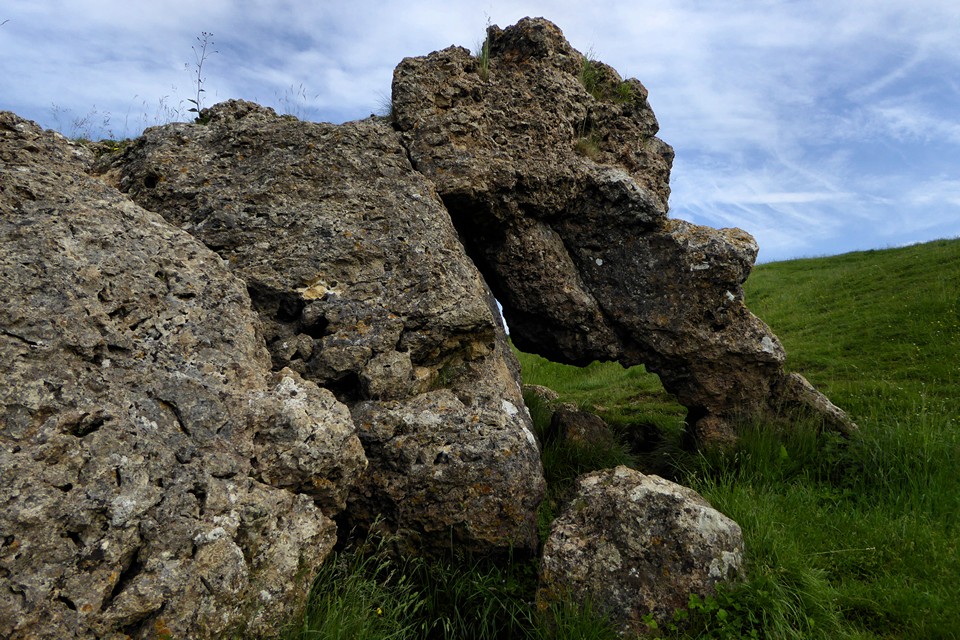





Looking down on the Bambury Stone from Parson’s Folly.

Woodcut by Jabez Allies, showing overhead view of the four “nearly” aligned stones. See misc.

It is easy to see why the Banbury Stone is known locally as the Elephant Stone.
In"On The Ancient British, Roman, and Saxon Antiquities and Folk-Lore of Worcestershire” 2nd ed (1852), Jabez Allies includes an entire chapter on the stone, including entymology of the name and a woodcut. He refers to a reference to the site in Laird’s “Topographical and Historical Description of Worcestershire” (1814), which gives the opinion:
“Near the Prospect House, is Bramsbury Stone, an immense mass of rock, but of which there is no traditionary account; and which is, most likely, merely a natural production, without any reference to ancient events.”
It is shown on Dr Nash’s plan of the camp (1781) and on Greenwood’s map (1820).
Allies gives a full description of the stone, which also mentions a line of other stones, nearly aligned with the Bambury Stone (as shown in his woodcut).
He concludes the chapter as follows:
“From all that has been said, and considering that Ambreley, Amberley, Ambresbury, and Ambury [as in Croft Ambrey ], are common names of old earth works all over the kingdom, it appears more than probable that Amber Stones stood at such places in primitive times, which gave the names thereto; and that the Banbury or Bambury Stone or Rock in Kemerton Camp, otherwise Bambury Camp, on the top of Bredon Hill, was one of these Ambrosiae Petrae, or Amber Stones, dedicated to the Sun by the Celtic Druids, either in imitation or independently of the form of worship of the Amonians, Phoenecians, or Tyrians. This would, if so, tend to confirm my idea that the Kemerton Camp is ancient British, although afterwards occupied by the Romans, Saxons, and Danes.”
Not sure if any of this helps the question of “disputed antiquity” in any way shape or form!
In Harold T. Wilkins’ book Mysteries Solved & Unsolved he suggests that the stones name is derived from Ambrosie petrie the annointed stone. Meanwhile Doreen Valiente states that another possible origin of the name is from the Latin word ambire meaning to go round and that the stone was danced around. Both authors mention the stone was a focus for witchcraft ceremonies in centuries past.
.. the Banbury Stone [is] also known as the elephant stone because of its shape when viewed from one side.. [it] has been described as a sacrificial stone for Druids or as a Roman altar, but in reality is a natural outcrop. Locals believed that to kiss the stone on Good Friday would bring bad luck.. [The Stone is] situated inside the hillfort, the outstanding feature of the hilltop.
p135 in A Year of Walks in the Cotswolds By Roy Woodcock (1998).
Also known as the ‘Elephant Stone’, it’s a natural conglomerate stone within the fort.
“Cottagers at the foot of Bredon Hill, near Tewkesbury, assured me in 1906 that there is treasure hidden near or under the Bambury Stone, which goes down to the Avon to drink when it hears the clock strike twelve.”
From: Cotswold Place-Lore and Customs, by J. B. Partridge, in Folklore, Vol. 23, No. 3. (Sep., 1912), pp. 332-342.
Description of the stone from “On The Ancient British, Roman, and Saxon Antiquities and Folk-Lore of Worcestershire” 2nd ed – Jabez Allies (1852):
“It is situated a little within the entrance of an oblong basin or amphitheatre, near the western focus of the ellipse, and is about twenty yards in circumference, four yards high, and nearly flat at the top. The basin resembles a dry dock, with its entrance upon the verge of the precipice of the hill, and is about two hundred yards in circumference. The stone, at several miles distance, looks something like the hull of a ship coming out of dock. I have no doubt that this basin is artificial, and that the earth and stones excavated were applied towards forming the inner agger of the camp, which is high and wide, and would take more materials in the making than could be obtained out of the vallum or trench. The stone is a mass of inferior oolite, the same as the rest of the hill, and no doubt was denuded upon the basin being dug, and most probably was preserved for an altar stone*. At the distance of about six yards before it, westward, nearer the precipice, there is another stone about eleven yards in circumference, and two yards above the surface; and about sixteen yards further westward, at the precipice, is a third stone, about ten yards in circumference,and two yards high. The former of these two stones was probably disturbed at the time of the excavation, as the stratification is nearly vertical, and the other appears to have been moved to the very edge of the (down which it seems on the point of rolling into Worcestershire), or the earth has, in the course of ages, fallen away from it down the precipice, and left it upon the brink. There is also another stone, behind and to the east of the Bambury stone, which measures about eight yards in circumference. All these stones are nearly in line with each other, and stand in an easterly and westerly direction; the one on the brink, stands on or near the site of the ancient granary.**”
*Mr Allies is keen on Druids.
**See miscellaneous entry under Kemerton Camp.




































